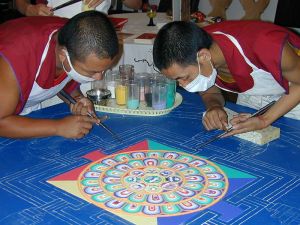Dance, Sand Mandala of the Arts
by Andrew Swensen

Alvin Ailey American Dance Theater (http://www.alvinailey.org/)
Dance is the sand mandala of the arts.
Certain art forms have a solidity to them, a lasting quality that defines them. Literature fits in here. Though you can change the cover, the typeface, the context of the reading, and the reader response, the work itself endures. Tale of Two Cities is always going to start with the same line about the best of times and the worst of times, and no one can change it. Emily Dickinson’s “Because I could not stop for death” is written and done (and I love it just the way it is). Painting and sculpture also fit into the realm of the solid. The artifact is what it is, regardless of how many times one visits it. We come and go from its presence, and it remains unmoving and unchanged. Indeed part of the power for all such works is the tension, the paradox, between their unchanging nature and the ever varying impact that they have on us. My relationship to Monet may evolve, but those water lilies have not altered a bit.
The performing arts stand in a different realm. The immediate presence of the artists in a live performance creates a fundamentally different aesthetic experience. Not better or worse necessarily, but operating in a different sphere of the artistic brain. In a museum or the pages of a book, we linger over something. We step back and forth, look at brush strokes, re-read a line of a poem. We have as much time as we want to engage the work, reflect, and move on. By contrast, the performing arts have an energy to them that belongs singularly to them, an energy born of the instant and of the dynamism between artist and audience on any given night. As any actor will attest, live performance is always different from rehearsal. The stakes are higher, the emotional investment greater. It is the difference between rough draft and printed copy, but for this printed copy, you have no opportunity to double-check typos.
Yes, their ephemeral quality invests them with urgency and tension, because the art work is happening in real time right before your eyes.
For a variety of reasons, I would argue that dance stands apart as the most dependent on the ephemeral for its distinct beauty and impact. In theater, we still have a script and perhaps even one with which we are familiar, and so we see a performance to appreciate the artistry of interpretation by a particular group of actors, set designers and a director. Yet one core quality of the work still can sit on a book shelf. Similarly for music, we have a host of choices in tempo, textures and dynamics, and all strike us for their particular musicianship brought to an enduring piece that has a score and likely a recording. In dance, however, the magnificence of the highest artistry is compressed in the smallest and most fleeting of moments. A single breathtaking leap, a single elegant combination can fill us with awe, ask a question, wrestle with humanity, and touch us with beauty.
The best analogy to which I can compare the experience is the Buddhist tradition of sand mandalas. Buddhist monks labor for a long period of time to compose a mandala designed of colored sand, and then they let the sand blow away in the wind. The sand mandala is also a thing of aesthetic effect, but I do not mean to compare one art form to another. Rather, the sand represents a meditation, a discipline and practice of laboring to compose something only to see it dissolve as dust in the wind. The lesson is in its impermanence, its ephemeral nature, and from that one learns to appreciate the wisdom in the labor and appreciate the fleeting nature of certain joys that should be seized in their moment, savored, and then let go.
Dance is about the instant. Dance matters because it reflects how much effort can go into a single, fleeting gesture. It matters too for those of us in the audience because we must seize that moment with relish, ever knowing how quickly it will pass. This moment is that place of awe, that instant when we are stunned by a question asked through movements of the body, that second when grace hits us like a lightning bolt and disappears just as quickly.
It is no accident that photography is a friend to dance because photography is in the business of capturing the “decisive moment.” A photograph of a dancer is still a different art form, and in a way it is the obverse side of the same coin, the same paradox turned on its head. In photography, a single moment is frozen and becomes lasting, directly in contrast to the “reality” that it represents: movement becomes static. Our appreciation of it depends on our awareness of the instantaneous that has been rendered permanent. So we marvel at dance photography such as the impressive series done by Alvin Ailey, for it gives us a chance to capture the fleeting.
Yet come back to the dance itself. Like the sand mandala, and not a photograph of it, the viewing of dance connects us to our relationship with time. It compels toward the realization that each moment might contain a gesture of the ineffable. Because of that, our attention can never wane. Dance matters because, more than any other art form, it compels us to stay aesthetically alert and teaches us that we should regard each moment as one that may contain wonder, inspiration, release, sorrow, joy, and awe. More than any other art form, dance teaches the meaning of momentary infinity in how the body moves, even as those movements dissolve away like dust in the wind.











Trackbacks & Pingbacks